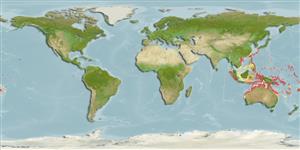>
Anguilliformes (Eels and morays) >
Muraenidae (Moray eels) > Uropterygiinae
Etymology: Uropterygius: Greek, oura = tail + Greek pterygion = little wing. Fin (Ref. 45335); nagoensis: Named after Nago, its type locality..
Environment: milieu / climate zone / depth range / distribution range
Ekologi
laut dasar (demersal); kisaran kedalaman 3 - 30 m (Ref. 90102). Subtropical; 31°N - 36°S, 94°E - 172°W
Indo-Pacific: only from the Red Sea to the Society and Solomon Is., north to Japan, south to Australia.
Size / Weight / umur
Maturity: Lm ? range ? - ? cm
Max length : 80.0 cm TL jantan/; (Ref. 121606)
deskripsi pendek
Morfologi | Morfometrik
vertebrata, bertulang belakang: 136 - 138.
Inhabits caves and crevices of coral reef in about 10-30 m (Ref 90102).
Life cycle and mating behavior
Kematangan | Reproduksi, perkembang biakan | Pemijahan | telur-telur | Fecundity | Larva
Masuda, H., K. Amaoka, C. Araga, T. Uyeno and T. Yoshino, 1984. The fishes of the Japanese Archipelago. Vol. 1. Tokai University Press, Tokyo, Japan. 437 p. (text). (Ref. 559)
Status IUCN Red List (Ref. 130435)
ancaman kepada manusia
Harmless
penggunaan manusia
informasi lanjut
Nama-nama umumSinonim (persamaan)metabolismePemangsaEkotoksikologiReproduksi, perkembang biakanKematanganPemijahanSpawning aggregationFecunditytelur-telurpekembangan telor
Umur / SaizPertumbuhanpanjang-beratpanjang-panjangukuran frekuensiMorfometrikMorfologiLarvaDinamika larvapemulihanKelimpahanBRUVS
AcuanBudidaya airprofil budidaya airStrainGenetikaElectrophoresesDiturunkanPenyakit-penyakitPengolahanNutrientsMass conversion
mitraGambarStamps, Coins Misc.Suara-suaraCiguateraKecepatanTipe renangArea insangOtolithsOtakPenglihatan / visi
Alat, peralatan
laporan khas
muat turun XML
Sumber internet
Estimates based on models
Preferred temperature (Ref.
123201): 24.6 - 29.3, mean 28.4 °C (based on 1733 cells).
Phylogenetic diversity index (Ref.
82804): PD
50 = 0.5000 [Uniqueness, from 0.5 = low to 2.0 = high].
Bayesian length-weight: a=0.00069 (0.00033 - 0.00144), b=3.12 (2.93 - 3.31), in cm total length, based on LWR estimates for this (Sub)family-body shape (Ref.
93245).
Trophic level (Ref.
69278): 3.6 ±0.6 se; based on size and trophs of closest relatives
Daya lenting (Ref.
120179): Rendah, Waktu penggandaan populasi minimum 4.5 - 14 tahun (Preliminary K or Fecundity.).
Fishing Vulnerability (Ref.
59153): Moderate to high vulnerability (52 of 100).
Nutrients (Ref.
124155): Calcium = 63.2 [37.8, 128.6] mg/100g; Iron = 0.904 [0.515, 1.532] mg/100g; Protein = 18.7 [16.5, 21.1] %; Omega3 = 0.257 [0.115, 0.648] g/100g; Selenium = 26.2 [14.1, 57.9] μg/100g; VitaminA = 11.4 [3.3, 40.0] μg/100g; Zinc = 0.655 [0.472, 0.930] mg/100g (wet weight);
